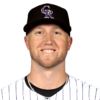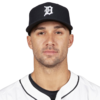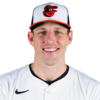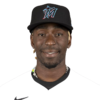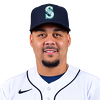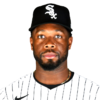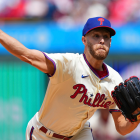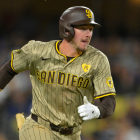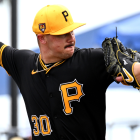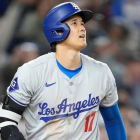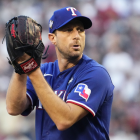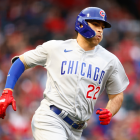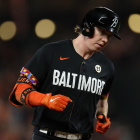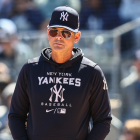The old saying is it takes five years to evaluate a draft class, though I've always felt that was a little generous. Three years is usually enough time to give teams an idea of what they have. There are always exceptions, but after three years, the prospects should have separated themselves from the suspects.
With the 2019 amateur draft set to begin Monday, this is as good a time as any to go back five years and review the 2014 draft. That 2014 draft class has not yet produced a major award winner, but it did produce two of the top four finishers in last year's National League Cy Young voting, plus a bunch of All-Star Game appearances as well.
Wins Above Replacement, or WAR, is neither perfect nor the definitive stat to measure performance. It does work very well for an exercise like this though. So, with an assist from Baseball-Reference.com, let's review the 2014 draft class.
The top pick
The No. 1 pick of the 2014 MLB draft deserves its own section. The Astros, after losing 111 games in 2013, secured the No. 1 pick in 2014. It was their third consecutive No. 1 pick. They took Carlos Correa with the top selection in 2012 (a huge hit) and Mark Appel with the top selection in 2013 (a huge dud).
Houston used the No. 1 pick in 2014 on Southern California high school left-hander Brady Aiken. Aiken was the consensus top prospect for the 2014 draft class and MLB.com lauded his "athleticism and his feel for pitching," and said he had a "chance to develop three above-average or better offerings." Aiken had all the ingredients necessary to become a big league ace.
The Astros and Aiken reportedly agreed to a $6.5 million signing bonus soon after the draft, which would've been a record bonus for a high school pitcher. However, during his pre-signing physical the Astros were scared away by something in Aiken's elbow, and they pulled their $6.5 million offer. Ken Rosenthal, then writing for FOX Sports, has the details:
The Astros, at a time of mounting concern about elbow injuries to pitchers, believe that Aiken's physical revealed a "significant abnormality" in the area of his elbow ligament, according to major-league sources.
...
The Astros, (agent Casey) Close said, made one revised offer to Aiken of $3,168,840 million – the minimum amount required to ensure that they would receive the second overall pick of the 2015 draft as compensation if they failed to sign Aiken.
Why would the Astros risk more than $3.1 million on Aiken but not $6.5 million? In part, sources said, to protect their rights to the 2015 pick – and in part because that they believe that Aiken was worth the investment at the lower number.
Aiken became only the third No. 1 pick not to sign, joining Danny Goodwin (White Sox in 1971) and Tim Belcher (Twins in 1983). The Astros received the No. 2 pick in 2015 as compensation -- Houston used that pick to select Alex Bregman -- and Aiken enrolled in a postgraduate baseball program at IMG Academy in Florida. He left his first game with IMG with elbow discomfort and underwent Tommy John surgery in March 2015.
Despite that, the Indians selected Aiken with the 17th overall pick in the 2015 draft and paid him a $2.5 million bonus. He has struggled tremendously as a pro, throwing 179 innings with 128 walks and a 5.18 ERA. Aiken's velocity has been down since elbow reconstruction, and earlier this month Driveline Baseball, a state of the art training facility used by several MLB players, sent out an Instagram story showing Aiken working out at their facility.
While the Astros surely would've loved to add a healthy Aiken to their farm system -- they didn't take him with the No. 1 pick not to sign him -- things worked out well because it led them to Bregman. For Aiken, he still received a seven-figure bonus, but he had to wait another year to get it, and he hasn't been the same pitcher since his senior year of high school in 2014.
Top 10 players to date
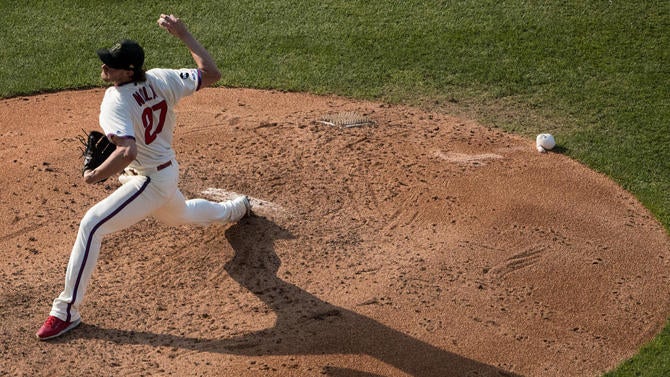
Somehow Aaron Nola was the fourth pitcher taken in the 2014 draft. The Phillies grabbed him with the No. 7 pick and 13 months later he was in the big leagues. Nola owns a career 3.44 ERA in 633 2/3 innings and was a deserving All-Star last season. He also finished third in the Cy Young voting behind Jacob deGrom and Max Scherzer, and even finished 13th in the MVP voting.
At the time of the draft Nola, an LSU product, was heralded for his running fastball and his changeup, and his ability to pitch to both sides of the plate with that fastball. The Phillies helped him improve his breaking ball the last few years, which has allowed Nola to make the jump from interesting prospect to MLB ace. He is the 2014 draft's best player to date and, rather easily, the draft's best pitcher.
Matt Chapman's development these last few seasons has been nothing short of remarkable. Everyone knew he had power and was a potential Gold Glove defender at third base going into the 2014 draft. The question was whether he'd make enough contact to produce against upper level pitching. The Athletics believed in his ability to make adjustments, and check out Chapman's strikeout rates over the years:
- 2016 in Double-A and Triple-A: 29.4 percent
- 2017 in Triple-A and MLB: 29.8 percent
- 2018 in MLB: 23.7 percent
- 2019 in MLB: 16.5 percent
Over the last four years Chapman has climbed from Double-A to the big leagues and managed to cut his strikeout rate nearly in half. That is awfully impressive. Chapman has not yet been selected to an All-Star Game -- I have to believe that'll happen this summer -- but he did win a Gold Glove last year and finished seventh in the MVP voting.
Is it just me or is Michael Conforto flying under the radar as one of the game's great hitters? He went into Thursday night's game as one of only 15 qualified hitters with a .400-plus on-base percentage, and his overall offensive output (155 OPS+) more or less matches rookie sensation Pete Alonso's (157 OPS+). Conforto was in the big leagues 13 months after being drafted and that October he became the third youngest player with a two-homer game in the World Series.
Only Andruw Jones (19 years and 180 days) and Tony Kubek (21 years and 358 days) were younger than Conforto (22 years and 244 days) at the time of their two-homer games in the Fall Classic. If not for a shoulder injury that cut short his 2017 breakout season and threw a wrench into his 2018 follow-up, I think Conforto would get more attention for being as great as he's been. The Mets hit a home run with this pick, no pun intended.
As is often the case with pitchers who call Coors Field home, Rockies lefty Kyle Freeland has been up and down in his three years as a big leaguer. Last season he threw 202 1/3 innings with a 2.85 ERA and finished right behind Nola in the Cy Young voting. This year he has a 7.13 ERA. Ouch. Still, Freeland, a hometown kid from Denver, reached the big leagues less than three years after being drafted and has had big league value. The ERA this season is an eyesore, I know, but I feel good betting on Freeland to perform better going forward.
Trea Turner has had an eventful pro career. For starters, he went into his draft year at NC State as a No. 1 overall pick candidate, but concerns about his swing caused him to fall to the Padres and the No. 13 pick. Six months after being drafted, Turner was sent to the Nationals as a player to be named later in the Wil Myers three-team trade with the Rays. The full trade:
- Padres receive: Wil Myers, Jose Castillo, Ryan Hanigan
- Nationals receive: Joe Ross and a player to be named later
- Rays receive: Steven Souza, Jake Bauers, Rene Rivera, Burch Smith, Travis Ott
Technically, Ross and Turner were traded to the Tampa, who then flipped them to Washington for Souza. Anyway, Turner was a player to be named later because, at the time, MLB's rules prevented teams from trading players until one year after they sign their first pro contract. Teams got around that by including them in trades as players to be named later, and naming them after the one-year waiting period was up. (Players to be named have to be named with six months.)
The three-team trade went down on December 19, 2014. It wasn't until June 14, 2015, that Turner was officially sent to the Nationals. He was going to Washington. It was an open secret. For all intents and purposes, the Nationals had a prospect -- a great prospect at that -- playing in San Diego's farm system for a few months in 2015. Eventually Turner was able to join the Nationals and he is now a dynamic two-way shortstop who finished second to Corey Seager in the 2016 Rookie of the Year voting. So much for those concerns about his swing, huh?
(Following Turner's weird situation, MLB changed their rules regarding trading recently signed players. Now they can be traded six months after signing their first pro contract.)
To this day there are talent evaluators who say Carlos Rodon's slider is the best breaking ball they've ever seen at the college level. It was a wipeout pitch that received rare 80s on the 20-80 scouting scale. Here's a GIF of Rodon's slider at NC State (via FanGraphs):
I am tweeting this GIF so I can easily embed it into a post. pic.twitter.com/dXgFhmhph8
— Mike Axisa (@mikeaxisa) May 30, 2019
Absurd. Rodon's slider hasn't been quite that good in pro ball -- the seams on the college ball are raised a little more than the MLB ball, allowing pitches to break more (that presents one of the many challenges of evaluating college pitchers) -- but he reached the big leagues 10 months after being drafted and has been a serviceable starter for the White Sox the last four seasons and change. Rodon recently underwent Tommy John surgery.
To date, the best player from the 2014 draft taken after the first round is Marlins third baseman-turned right fielder-turned third baseman Brian Anderson. He made his MLB debut as a September call-up in 2017 and finished fourth in the Rookie of the Year voting in 2018, his first full big league season. Anderson was seen as a potential first rounder in 2014 based on his tools and athleticism, but a down junior year at Arkansas -- "down" is relative here, because Anderson hit .328/.401/.498 for the Razorbacks that spring -- caused his draft stock to slip. Miami pounced in the third round and hasn't regretted it for a second.
Phillies slugger Rhys Hoskins is a scouting and player development success story, plain and simple. He was seen as a lumbering masher at Sacramento State, but Philadelphia recognized his excellent feel for hitting and identified him as a player who could make big gains thanks to his work ethic. That is exactly what happened. Hoskins is now a legitimate middle of the order hitter for a contending team and a player the Phillies can build around. If not for last season's ill-fated left field experiment -- Hoskins was worth minus-3.6 WAR on defense alone in 2018 -- Hoskins would be much higher on this list.
The Yankees have become an excellent player development organization and Jordan Montgomery is one of their better success stories. He was a four-pitch guy with a fastball that sat around 90 mph at South Carolina. The Yankees helped him add a little velocity and sharpen his curveball, and three years later he won a big league rotation spot after going to spring training as a non-roster invitee. Montgomery finished sixth in the 2017 Rookie of the Year voting and is expected to rejoin the Yankees some time after the All-Star break this year, after he completes his Tommy John surgery rehab.
Jack Flaherty was one of my favorite prospects going into the 2014 draft and the Cardinals have developed him into exactly the kind of pitcher he projected to be when they took him out of a Southern California high school. Flaherty showed three potential swing-and-miss secondary pitches with very good command and pitching know-how, and St. Louis has helped him add a little velocity and refine his entire arsenal. Last year Flaherty struck out 182 batters in 151 innings and finished fifth in the Rookie of the Year voting. There are few 2014 draftees I would be more willing to hitch my wagon to going forward than Flaherty. The Cardinals, by the way, selected Flaherty with the compensation pick they received for losing Carlos Beltran to free agency.
To date, seven other 2014 draftees have provided at least +2 WAR of big league value. The seven:
- Brandon Woodruff, Brewers (11th round, 326th pick): +3.3 WAR
- Sean Newcomb, Angels (1st round, 15th pick): +3.0 WAR
- Kyle Schwarber, Cubs (1st round, 4th pick): +2.9 WAR
- Ramon Laureano, Astros (16th round, 466th pick): +2.5 WAR
- Brandon Finnegan, Royals (1st round, 17th pick): +2.3 WAR
- Daniel Mengden, Astros (4th round, 106th pick): +2.2 WAR
- Alex Verdugo, Dodgers (2nd round, 62nd pick): +2.1 WAR
Finnegan (2014 Royals) and Schwarber (2016 Cubs) have played in the World Series, and four of those seven players have been traded. Newcomb was the headliner in the Andrelton Simmons deal. Kansas City used Finnegan to get Johnny Cueto in 2015. The A's acquired Mengden from the Astros in the Scott Kazmir trade and Laureano in a minor swap in November 2017.
Best picks after the 10th round
First-round picks get all the attention and understandably so, though late-round picks are often the difference between contenders and pretenders. The ability to find hidden gems and turn those late-round picks into useful big league players -- even if they're middle relievers or bench players -- can make a huge difference in a pennant race. Here are the best players drafted after the 10th round in 2014.
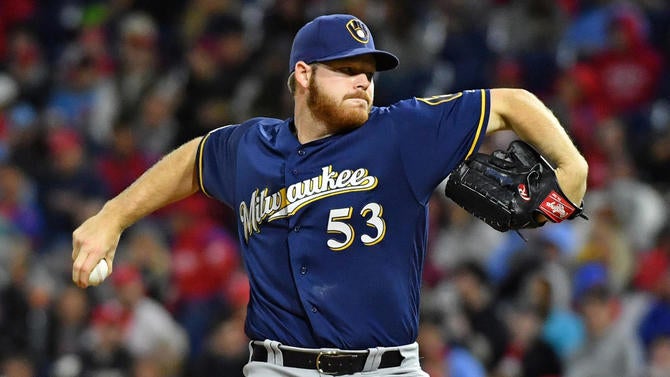
Injuries and a draft year demotion to the bullpen took a bite out of Woodruff's stock at Mississippi State, though he showed enough raw stuff for the Brewers to grab him in the 11th round. Since then he's greatly improved his delivery and thus his command, and he's emerged as a bulldog starter with the versatility to pitch in pretty much any role. Milwaukee did an excellent job identifying a pitcher with the raw tools, work ethic, and acumen to improve in pro ball.
Astros GM Jeff Luhnow recently admitted he didn't realize what he had in Laureano when he shipped him to the division rival A's for minor league righty Brandon Bailey in November 2017. "We had a feeling (Laureano) was going to be a pretty good big league player, but he's gotten off to a faster start in his career than we thought. So, yeah, he's one that I'd love to have back," Luhnow told Chandler Rome of the Houston Chronicle last month. Laureano wasn't a notable prospect at Northeastern Oklahoma A&M College, but he's made adjustments over the years to become a better hitter and maximize his defensive skills. Oakland did very well identifying him as an undervalued player. (Bailey, by the way, has a 5.09 ERA in Double-A this year.)
Less than a year ago John Means looked like an up-and-down depth pitcher, and, generally speaking, that's a good outcome for an 11th-round pick. The Orioles' new player development staff has helped him improve his changeup, however, and now Means is establishing himself as a potential building block for a rebuilding club. He is a few innings short of qualifying for the ERA title with a 2.80 ERA and one of the lowest hard contact rates in baseball. Nice little parting gift from the old O's regime.
Four other players selected after the 10th round of the 2014 draft have accumulated at last half-a-win of value at the big league level thus far. Not surprisingly, they are all pitchers. Most late-round success stories are pitchers who learned a new pitch or improved an existing pitch, or simply stayed healthy after dealing with injuries. The four:
- Aaron Bummer, White Sox (19th round, 558th pick): +0.7 WAR
- Jalen Beeks, Red Sox (12th round, 374th pick): +0.7 WAR
- Jacob Webb, Braves (18th round, 553rd pick): +0.6 WAR
- Josh James, Astros (34th round, 1,006th pick): +0.6 WAR
The Red Sox traded Beeks to the Rays for Nathan Eovaldi at the deadline last year and that makes the pick a smashing success for Boston. James has a chance to be an enormous success story. He was not selected in the 2017 Rule 5 Draft -- any other team could've had him for nothing but the $100,000 Rule 5 Draft fee and a 40-man roster spot -- before breaking out in 2018 and becoming a top pitching prospect.
Jury still out
Even though players are getting to the big leagues and having an impact quicker than ever before, there are several 2014 draftees who are either still developing in the minors or just now getting their feet wet in the big leagues. These players aren't busts. They're still developing. Here are five 2014 draftees who are on the cusp of making a name for themselves.
Nick Gordon, Tom Gordon's son and Dee Gordon's younger brother, is unfortunately trending toward "bust" territory. He is a career .274/.328/.380 hitter in over 2,500 minor league plate appearances, and that includes a .227/.274/.315 batting line in just about a full season's worth of Triple-A playing time. That said, Gordon will play the entire season at age 23 and he plays a premium position (shortstop and second base), plus he has good genes, so there's no need to cut bait yet. I'm sure the Twins were hoping he'd be in the big leagues by now when they made him the fifth overall pick in 2014, however.
Baseball can be cruel. The Red Sox selected Kopech with the 33rd overall pick, developed him into one of the top pitching prospects in baseball, then traded him to the White Sox as part of the package for Chris Sale. Kopech made his MLB debut late last season and long-suffering ChiSox fans were about to have a very exciting young starter in the rotation ... and then Kopech blew out his elbow and needed Tommy John surgery in his fourth MLB start. Like I said, baseball can be cruel. Kopech will look to continue his ascent to ace-hood with his new elbow ligament in 2020. (Boston selected Kopech with the compensation pick they received for losing Jacoby Ellsbury to free agency, by the way.)
Justus Sheffield is well-traveled, if nothing else. The Indians traded him to the Yankees in the Andrew Miller deal back in 2016, then the Yankees flipped him to the Mariners in the James Paxton trade over the winter. Sheffield has been a bit up-and-down in Triple-A this year (4.13 ERA with 30 walks and 40 strikeouts in 48 innings), but he remains one of the game's best prospects, and is on the path to becoming a rotation mainstay for Seattle in the near future. (The Indians selected Sheffield with the pick they received as compensation for losing Ubaldo Jimenez (!) to free agency.)
It is baffling the Diamondbacks -- under their old front office regime, it should be noted -- essentially gave Touki Toussaint to the Braves to get them to take Bronson Arroyo's contract off their hands a year after the 2014 draft. Toussaint developed into one of the game's better pitching prospects in the subsequent years and he's pitched well in sporadic time with Atlanta, striking out 58 in 52 innings the last two years. He's still trying to find a set role in an organization loaded with young arms.
Even though he had Tommy John surgery a month before the draft, the Blue Jays selected Jeff Hoffman with the ninth overall pick, and one year later they sent him to the Rockies in the Troy Tulowitzki deal. Hoffman regained his previous stuff following surgery and became a very good pitching prospect, though he's ridden the Triple-A shuttle with Colorado and has yet to stick in the big leagues. Given his pedigree and near elite spin rates, Hoffman looks a potential buy-low candidate for a team that doesn't play its home games in Coors Field.
Biggest busts
Inevitably, some high 2014 draft picks simply have not worked out. That's baseball. Here are some of the most notable busts from the 2014 draft class.
Going into the 2014 draft, Tyler Kolek's velocity was nearly unprecedented in the draft era. He was a high schooler who regularly ran his fastball into the 99-102 mph range and showed the makings of quality second pitches as well. Injuries, including Tommy John surgery, and a lack of control have held him back in the minors, however. Kolek owns a career 5.34 ERA with 97 walks in 150 innings, none above Low Class-A. He is still active and in Miami's system, and is currently recovering from surgery to treat thoracic outlet syndrome.
Max Pentecost had all the tools to be a quality major league catcher, but his body just wouldn't let it happen. Years of injuries, most notably shoulder surgery in 2015 and subsequent complications, derailed his career. Pentecost played only 260 minor league games from 2014-18, topping out at Double-A last season. He announced his retirement from baseball soon after Opening Day this year. (The Blue Jays selected Pentecost with the compensation pick they received for failing to sign 2013 first rounder Phil Bickford.)
Few things in baseball are as terrible as the yips. It feels helpless as an outsider. I can't imagine what it's like being that guy out on the mound. Nick Howard, following a very productive college career at Virginia, lost the plate in pro ball. He walked 50 batters (and hit four others and had nine wild pitches) in 38 innings in 2015, then walked 31 (with two hit batsmen and 13 wild pitches) in 20 innings in 2016. The control problems lingered and injuries eventually set in. Howard is still with the Reds but he has not pitched this year. He has a 5.42 ERA with 126 walks in 113 strikeouts in 144 1/3 pro innings.
Casey Gillaspie, a Wichita State product, was a quintessential "he's going to hit" college masher. The problem? He never hit. Gillaspie is a career .250/.337/.418 hitter in the minors, which simply is not good for a bat-only first baseman. That includes a .239/.312/.389 batting line in 999 Triple-A plate appearances. The Rays sent him to the White Sox for lefty reliever Dan Jennings at the 2017 trade deadline, and while taking a chance on a former first rounder is a smart move for a rebuilding team, it didn't work out for Chicago. The ChiSox released Gillaspie at the end of spring training this year and he's currently playing in an independent league.
The ones who got away
As always, many players who were drafted in 2014 did not sign professional contracts. They opted to go to college -- or return to college, in some cases -- and re-enter the draft in future years. And, inevitably, some of the players who did not sign in 2014 went on to become top prospects in future years. Here are the biggest names who did not sign in 2014.
Back in 2014, J.B. Bukauskas was a high school junior who graduated early and thus made himself draft eligible. He sent a letter to teams telling them not to draft him because he was set on going to UNC, but the Diamondbacks took a shot on him anyway with their 20th-round pick. Hey, why not? Maybe the kid changes his mind. Bukauskas didn't. He went to UNC, dominated for three years, then the Astros selected him with the 15th overall pick in 2017. He is currently one of the top pitching prospects in the game.
The consensus was Griffin Canning would be better off going to college than turning pro out of high school in 2014. The raw tools and the feel for pitching were there, but he need to fill out his frame and mature as a pitcher. The Rockies took him in the 38th round in case he decided to turn pro, which he did not. Canning enjoyed a decorated career at UCLA and the Angels stole him with their second-round pick in 2017. He's already in the big leagues and has a 3.06 ERA with 34 strikeouts in 32 innings.
The Pirates made Paul DeJong, a draft-eligible sophomore at Illinois State, their 38th-round pick in 2014, but couldn't convince him to turn pro. DeJong went back to school, hit .333/.427/.605 with 14 home runs as a junior, then the Cardinals popped him with their fourth-round pick in 2015. Now he's their starting shortstop and producing at an All-Star level, and closing in on +10 WAR for his career. If not for the current draft spending restrictions, Pittsburgh might've upped their offer to DeJong in 2014 and gotten him to sign on the dotted line. Alas.
High school Brendan McKay was ahead of his time. Scouts weren't sure whether he projected better as a pitcher or hitter in high school, so he followed through on his commitment to Louisville and excelled at both. Three years later the Rays made McKay the 4th overall pick in the 2017 draft, and he is now a legitimate two-way prospect -- for what it's worth, the consensus is he has much more potential on the mound than at the plate -- nearing his MLB debut. The Padres tried to sign McKay as their 34th-round pick in 2014 but had no luck.












